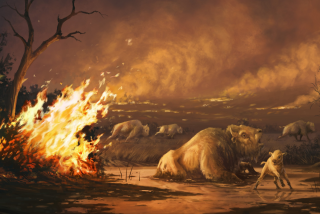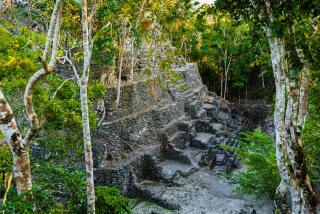Calico: Cooling the Fires of Speculation
Louis Leakey startled the archeological world in 1964 by suggesting that early man, or a hominid ancestor, had camped at the edge of a Pleistocene lake site near Yermo, Calif., in the Mojave Desert. Four years later his hypothesis gained credibility when scientists digging 50 feet down at the Calico site unearthed a strange semicircle of stones. Alternating in a pattern of three large cobbles with two smaller ones, it looked for all the world like a prehistoric hearth.
Since then other hearths, as well as more than 11,400 chips that resemble the scrapers, gravers and hammer stones of the Stone Age have been found. Yet the Calico site remains controversial.
No Fossils at Calico
Orthodox paleohistory has Homo sapiens migrating to the Americas from Asia across a long land bridge between 12,000 and 25,000 years ago. But the radiometric uranium/thorium tests of the crust on the Calico cobbles revealed that the hearths date back at least 200,000 years. Unlike the African digs that Leakey had sifted so successfully in finding Australopithecus bones, Calico has yielded no fossils. But if it can be shown that these supposed hearths were indeed fire sites, the argument in favor of ancient human habitation in the New World would gain enormous credence.
A preliminary paleomagnetic study of one of the rocks indicated that the inner or flameward side was more magnetic than the other part of the rock. The task of examining all of these cobbles with the most modern technology fell last summer to Caltech undergraduate Janet L. Boley. Born in the same year that Leakey selected the Calico site, she had been interested in geology since junior high school and was delighted at the chance to work under the supervision of Caltech Prof. Joseph Kirschvink. She was also eager to get a chance to use Squid, a state-of-the-art magnetometer, to examine the remnant magnetism in the ancient cobbles.
Stones, she explains, contain millions of magnetic crystals; they act like compasses, pointing to where the Earth’s magnetic poles were at the time the rocks were formed. Magnetization is stable in rocks over remarkably long periods of time. However, when they are heated to more than about 360 degrees centigrade, their magnetic orientation changes to face the direction of the magnetic pole at the time of the reheating. Thus the clock is reset--as when pottery is fired or flint is burned. So if there had been fires in the Calico hearths, the cobbles would reflect that fact.
The curator of the Calico site, Fred Budinger Jr., along with other scientists, constructed a control hearth for the experiment. They gathered random stones from the same epoch as the cobbles, using them in building a hearth in which they set a bonfire for seven hours.
Boley went to work, first examining the cobbles in the real hearths, then those in the new control hearth. With surgical skill she removed cylindrical cores from each of the stones, drilling from the side facing the heat toward the outside. If a fire had been set, only the hottest part of the stones would have been affected. The parts facing away from the fire would probably have retained their original magnetic orientation, which could have been as old as 400,000 years.
With the cores removed, Boley sliced the sausage-shaped cylinders into narrow coin-like disks. She then measured the magnetic direction of each disk, always keeping track of the original orientation of the stone.
As she had expected, the cobbles in the control experiment showed evidence of heating remagnification. The parts of the stones nearest to the heat were realigned in the direction of today’s magnetic field. The outer sides were oriented at random.
But the cobbles from the ancient hearths all showed random magnetic directions. They had never undergone heating remagnification, and had therefore never been used as campfire sites.
Storage Sites? Pushy Saplings?
Boley is neutral on the question of whether or not the Calico dig is a true hominid site. She points out that although the strange semicircles were never hearths, they still could have been constructed as storage places. On the other hand, she suggests, the stones might have surrounded ancient saplings that, as they grew into trees, pushed the stones into semicircular patterns.
Had Boley’s results been different, paleolithic history would have had to be rewritten. As it stands, some archeologists argue that both the circles and the myriad stone chips are geofacts, products of nature, rather than artifacts, things made by human hands.
This kind of negative proof seldom makes headlines, yet it’s an important part of the scientific method, one of the means by which scientists winnow the wheat from the chaff. Boley’s work has not, of course, disproved Leakey’s hypothesis that ancient man once inhabited Calico, but she has removed from consideration a powerful piece of possible corroborating evidence.






